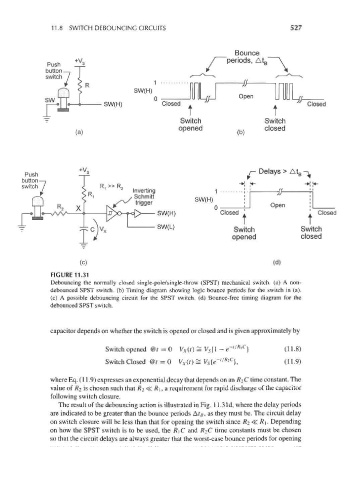Page 557 - Engineering Digital Design
P. 557
11.8 SWITCH DEBOUNCING CIRCUITS 527
Bounce
/periods , At B"
+v s
Push
button —,
switch /
Closed .
Switch
opened
(a)
Push - /-Delays >At B- lf
button—, -K T
switch !*- -*!«-
1 if—
SW(H)
Open
0
Closed A I Closed
t t
Switch Switch
opened closed
(c) (d)
FIGURE 11.31
Debouncing the normally closed single-pole/single-throw (SPST) mechanical switch, (a) A non-
debounced SPST switch, (b) Timing diagram showing logic bounce periods for the switch in (a),
(c) A possible debouncing circuit for the SPST switch, (d) Bounce-free timing diagram for the
debounced SPST switch.
capacitor depends on whether the switch is opened or closed and is given approximately by
/RlC
Switch opened @t = 0 V x(t) = V s{\ - e~' } (11.8)
/R2C
Switch Closed @t = 0 V x(t) = V s{e-' }, (11.9)
where Eq. (11.9) expresses an exponential decay that depends on an R^C time constant. The
value of ^2 is chosen such that 7? 2 <?C R\, a requirement for rapid discharge of the capacitor
following switch closure.
The result of the debouncing action is illustrated in Fig. 11.3 Id, where the delay periods
are indicated to be greater than the bounce periods Af B , as they must be. The circuit delay
on switch closure will be less than that for opening the switch since R^<^R\. Depending
on how the SPST switch is to be used, the R\C and R 2C time constants must be chosen
so that the circuit delays are always greater that the worst-case bounce periods for opening

